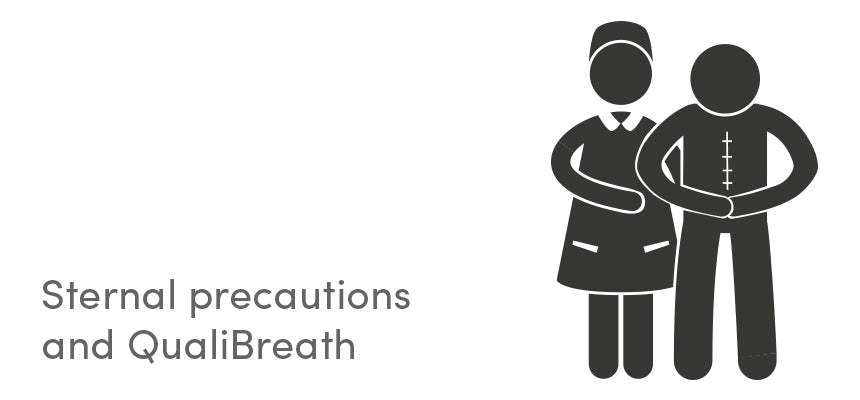Recovery after median sternotomy is often slowed down by too restrictive precautions.
Sternal precautions should be patient specific and focus on patient characteristics and function to improve recovery instead of slowing it down, authors Cahalin LP et al. write in an extensive literature research published in Cardiopulmonary Physical Therapy Journal. (*1.)
Find the original article here.
 QualiBreath (to the right) supports the sternum and improves postoperative recovery.
QualiBreath (to the right) supports the sternum and improves postoperative recovery.
The authors review available research related to median sternotomy procedures and the physical activity patients are allowed to do.
No universally accepted definition of sternal precautions exists for patients who have had a sternotomy.
The guide for precautions is usually anecdotal or expert opinion at best supported by indirect evidence. In most cases patients receive the same instructions over a fixed time-frame without regard to individual differences, risk factors for complications or clinical status of the recovery process.
Physical activities, functional tasks and recommended exercise are too restrictive in the immediate postoperative period, the authors write. Such restrictions can hinder an optimal sternal healing. As other muscles are not being exercised, the consequence can be atrophy of the chest wall muscles and weakening of the connective tissue structures.
The authors believe that numerous postoperative symptoms such as constant pain, impaired lung function and chest wall movement can be caused by overly restricting activities. They write that many other clinicians and researchers increasingly share the same view and are questioning whether sternal precautions are too restrictive.
Upper body exercise has a beneficial effect on circulation of blood in the arms and chest wall which promotes healing.
The authors have the opinion that an optimal degree and duration of activity should be based on the patients’ characteristics such as risk factors, comorbidities and previous activity levels etc. They also believe activities should have a progression in stages.
Cahalin et al. present a proposal for a step-by-step procedure with well-defined instructions for patient activity after sternotomy.
The algorithm presents a less restrictive and more individual, dynamic application of sternal precautions.
Patients are divided into risk categories for sternal complications based on known risk factors, clinical evaluation of the wound characteristics and other patient factors. The type and degree of activity precautions is determined according to the risk category for the individual patient. The algorithm allows for progression of activity based on each patient’s recovery characteristics in stead of a sudden lifting of all precautions at a certain time-point.
This publication is a strong support for QualiBreath:
QualiBreath is an elastic sternum and thorax support. It can be adjusted to be as firmly supportive on the patient’s chest as desired. Whatever risk category a patient is placed into, QualiBreath can be adapted to fit the patients specific characteristics and needs.
The precisely defined elasticity of the QualiBreath material will support the patient’s thoracic muscles during activities in stead of restricting them.
 QualiBreath gives a constant encircling support to the chest
QualiBreath gives a constant encircling support to the chest
while leaving the lower lung lobes and upper abdomen free for breathing and comfort.
QualiBreath, referred to as an adjustable fastening brace, is quoted in the publication:
“El-Ansary et al recently investigated the effects of supportive devices in patients with chronic sternal instability and found that use of an adjustable fastening brace [QualiBreath] improved pain and lessened sternal separation”.
The authors conclude: “A precautionary approach rather than restrictive approach is likely to better facilitate optimal sternal healing and functional recovery after a median sternotomy”. Their extensive literature research strongly confirmed that progressive rehabilitation is needed to improve thoracic motion, pulmonary function, symptoms and functional status after sternotomy.
It’s time for change. Sternal precautions must focus on function and patient characteristics to facilitate recovery rather than impede it.
What is your opinion on this ?
Leave a comment below.
References:
* 1. Sternal Precautions: Is It Time for Change? Precautions versus Restrictions - A Review of Literature and Recommendations for Revision.. Cahalin LP et al. Cardiopulmonary Physical Therapy Journal, Vol 22, No. 1, March 2011 Pg. 5-15


Leave a comment: